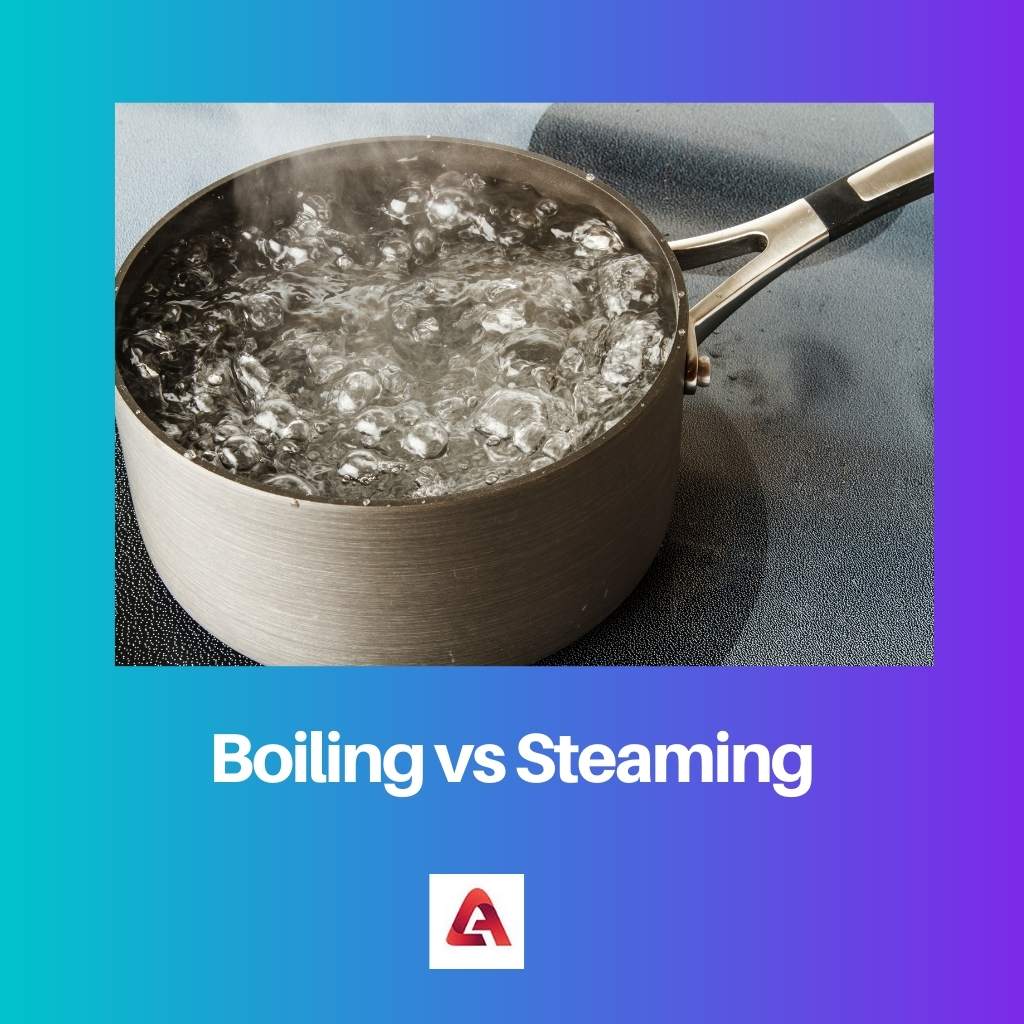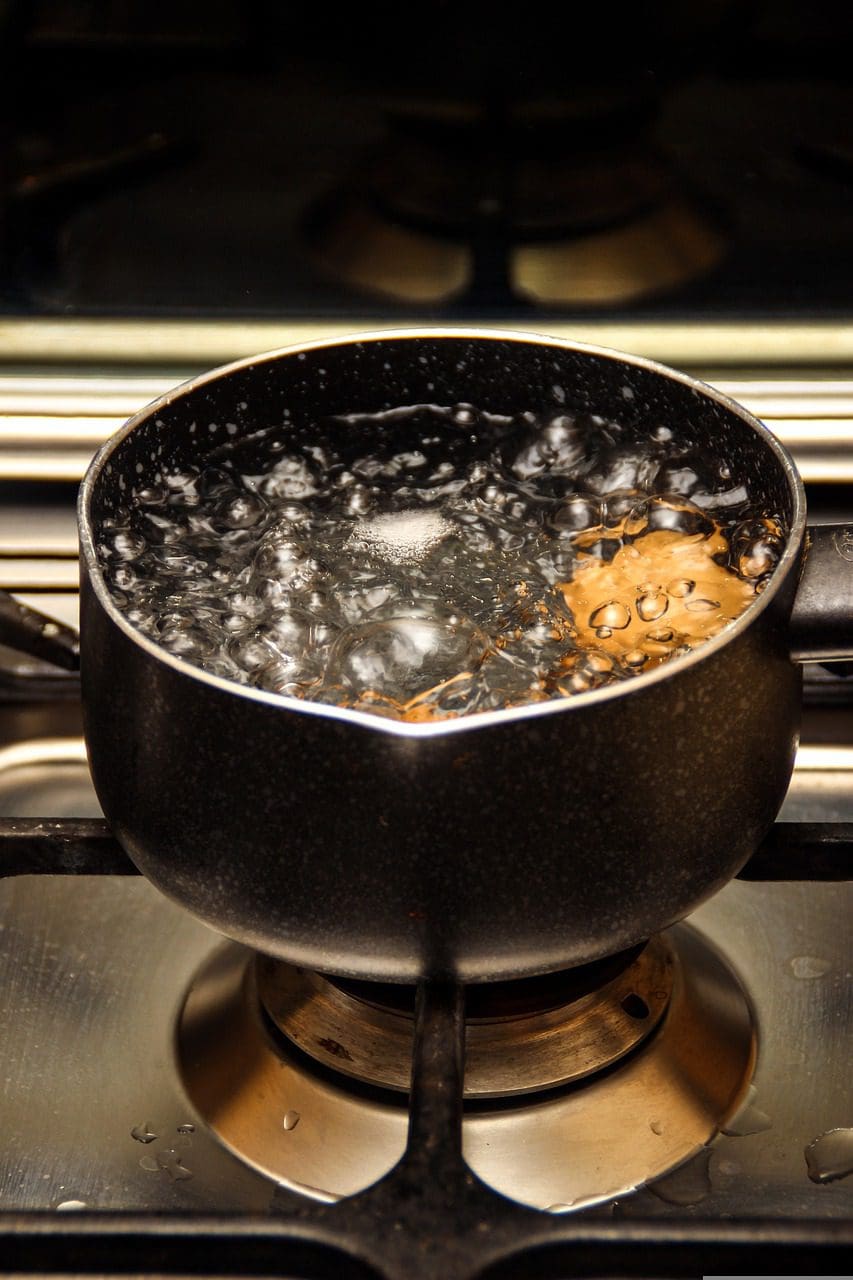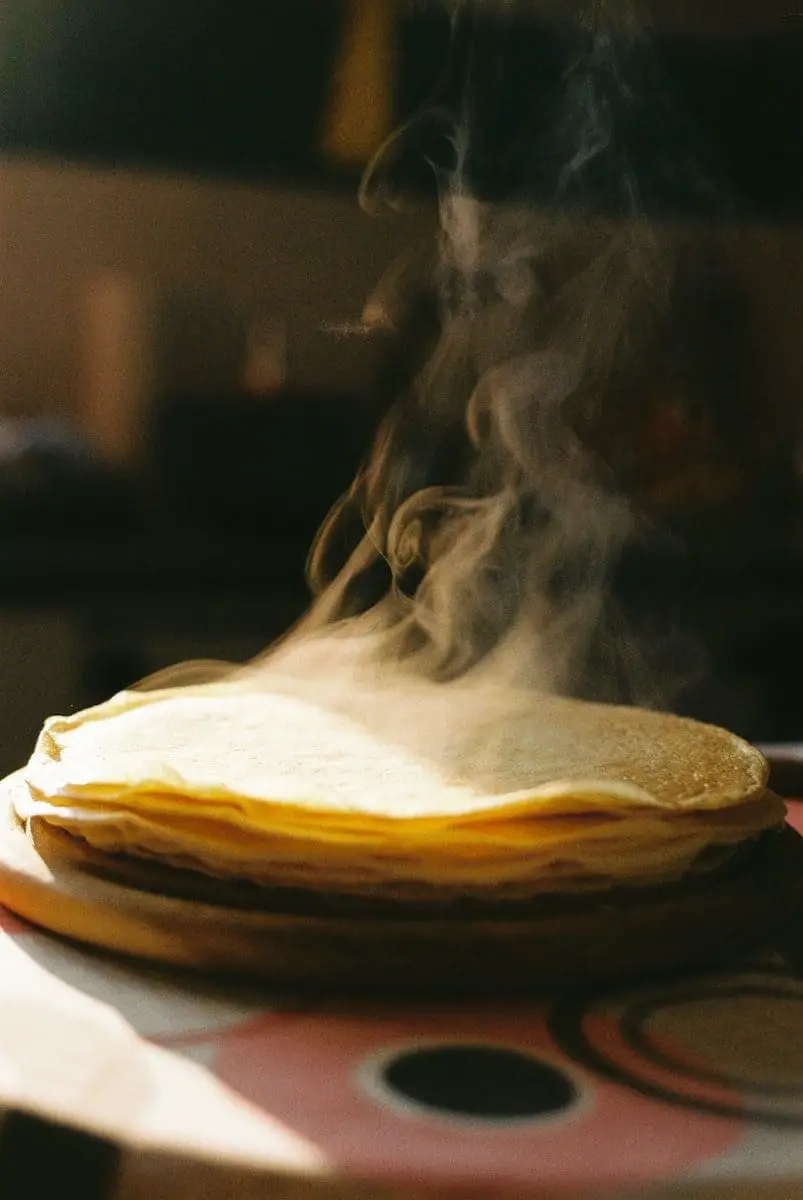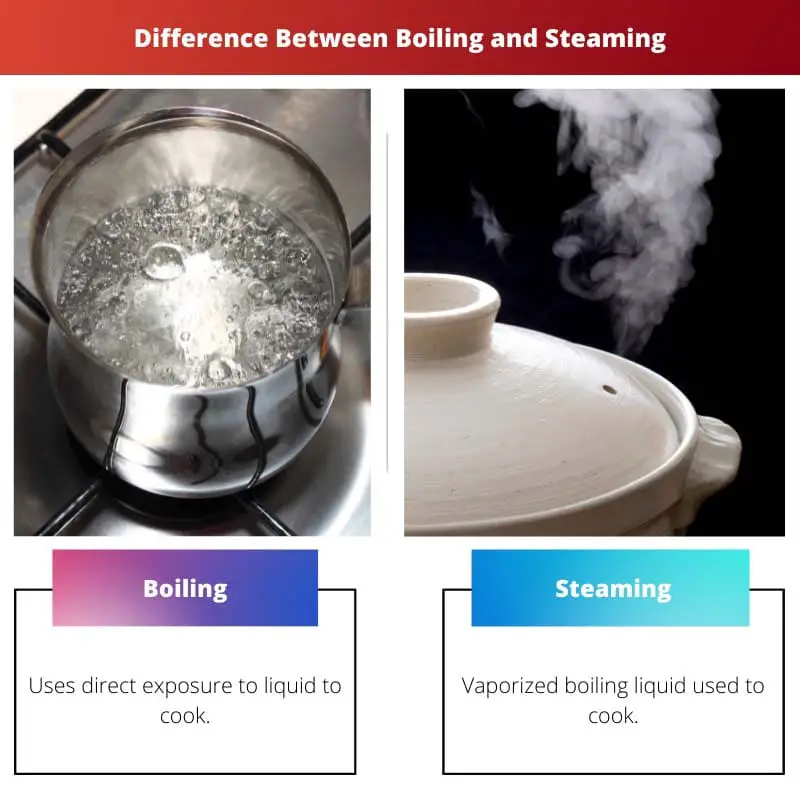Boiling involves immersing food in hot water, typically at 100 degrees Celsius, causing it to cook quickly. Steaming, on the other hand, cooks food by exposing it to steam above boiling water, retaining more nutrients as it doesn’t directly contact water.
Key Takeaways
- Boiling involves immersing food in a liquid at or above boiling temperature.
- Steaming is cooking food over boiling water without letting it directly contact the water.
- Boiling is more suitable for foods that need to be thoroughly cooked, while steaming is better for foods that need to retain shape, texture, and flavor.
Boiling vs Steaming
Boiling is a cooking method that involves heating a liquid to its boiling point when the liquid turns into steam rapidly. Steaming is a cooking method that involves using hot steam to cook food items and helps preserve the nutrients and flavours of the food.

Boiling is a moist way of preparing food where ingredients are immersed in some liquid, either brought or maintained to the boiling point. Heat is conducted via vessel surfaces to the liquid in it.
Steaming is a procedure for making food that needs moist heat. This heat gets produced via boiling water which converts into steam. This steam provides warmth to the ingredients and cooks them.
Comparison Table
| Feature | Boiling | Steaming |
|---|---|---|
| Temperature | Water reaches 212°F (100°C) at boiling point | Uses steam, typically around 212°F (100°C) but can vary slightly depending on the steamer design |
| Cooking Medium | Food submerged in boiling water | Food cooked by indirect heat from steam |
| Heat Transfer | Direct contact with hot water | Gentle heat transfer through steam |
| Nutrient Retention | Can leach out water-soluble vitamins and minerals | Generally better at retaining nutrients |
| Texture | Can soften food significantly, may lead to mushiness | Often results in a firmer, more crisp-tender texture |
| Suitability | – Pasta – Soups and stews – Starchy vegetables (potatoes, corn) | – Delicate vegetables (broccoli, asparagus) – Fish – Dim sum – Dumplings |
| Convenience | Simple, requires minimal equipment | Requires a steamer basket and pot with lid |
| Cleanup | May require cleaning a pot with boiled water residue | Typically easier cleanup, less mess |
What is Boiling?
Boiling is a phase transition process in which a substance changes its state from a liquid to a gas due to the absorption of heat. This phenomenon occurs when the vapor pressure of the liquid equals the atmospheric pressure surrounding it. Boiling is a crucial concept in thermodynamics and plays a significant role in various industrial, scientific, and everyday applications.
The Boiling Process
Boiling involves the conversion of a liquid into vapor, and it is characterized by the formation of bubbles within the liquid. This transition occurs when the temperature of the liquid reaches its boiling point at a specific pressure. The boiling point is the temperature at which the vapor pressure of the liquid equals the external pressure, allowing bubbles of vapor to form throughout the liquid.
Factors Influencing Boiling
- Pressure: Boiling points vary with pressure. At higher altitudes where atmospheric pressure is lower, liquids boil at lower temperatures. Conversely, at higher pressures, liquids require higher temperatures to reach their boiling points.
- Nature of the Liquid: Different liquids have different boiling points due to variations in intermolecular forces. Substances with stronger intermolecular forces generally have higher boiling points.
- Surface Tension: Surface tension can influence boiling. Substances with high surface tension may resist the formation of bubbles, requiring more heat for boiling to commence.
Types of Boiling
- Nucleate Boiling: This occurs when bubbles form at discrete sites on the heating surface. These bubbles grow and detach, contributing to the overall boiling process.
- Film Boiling: In film boiling, a continuous layer of vapor forms on the heating surface, hindering heat transfer. This type of boiling is more common at higher temperatures and with volatile liquids.
Applications of Boiling
- Cooking: Boiling is a common cooking method used to prepare various dishes. It is effective for cooking pasta, vegetables, and other food items.
- Power Generation: Boiling is crucial in power plants where it is used to produce steam, driving turbines to generate electricity.
- Chemical Processes: Many chemical reactions involve boiling as a step, such as distillation and separation processes in the chemical industry.
Boiling vs. Evaporation
Boiling and evaporation are both processes involving the conversion of a liquid to a gas, but they differ in key aspects. Boiling occurs at the boiling point throughout the liquid, while evaporation happens at the liquid’s surface at temperatures below the boiling point.

What is Steaming?
Steaming is a cooking technique that involves the use of steam to cook food. This method has been employed for centuries and is widely utilized in various culinary traditions across the globe. The application of steam in cooking offers several advantages, including the preservation of nutrients, enhanced flavor retention, and the ability to cook food without the need for added fats.
The Mechanism of Steaming
1. Steam Generation
Steaming involves the conversion of water into steam, which is then utilized to cook the food. This is typically achieved by heating water to its boiling point, at which it transforms into steam.
2. Steam Circulation
The generated steam circulates around the food, enveloping it in a hot, moist environment. This gentle and even heat distribution is conducive to uniform cooking.
Equipment and Methods
1. Steaming Equipment
- Steamer Baskets: These are commonly used in home kitchens, allowing for the suspension of food above simmering water.
- Bamboo Steamers: Traditional in Asian cuisine, these stackable baskets are ideal for steaming dumplings, vegetables, and more.
- Electric Steamers: Modern appliances that automate the steaming process, providing convenience in home kitchens.
2. Steaming Methods
- Basket Steaming: Placing food in a perforated basket over simmering water.
- En Papillote (In Parchment): Wrapping food in parchment paper or foil before steaming.
- Pressure Steaming: Utilizing pressure cookers to speed up the steaming process.
Culinary Applications
1. Vegetables and Fruits
Steaming is frequently employed to cook vegetables and fruits, preserving their vibrant colors and nutritional content.
2. Seafood
Delicate seafood, such as fish and shellfish, benefits from steaming, ensuring a moist and flavorful result.
3. Dumplings and Dim Sum
Steaming is integral to the preparation of various dumplings and dim sum in Asian cuisine, contributing to their unique textures.
Advantages of Steaming
1. Nutrient Retention
Steaming helps retain more nutrients in food compared to other cooking methods that involve higher temperatures and longer cooking times.
2. Preservation of Flavor and Texture
The gentle nature of steam prevents the leaching of flavors and helps maintain the natural textures of the ingredients.
3. Low-Fat Cooking
Since steaming doesn’t require the addition of fats, it is a healthier cooking option for those looking to reduce their fat intake.

Main Differences Between Boiling and Steaming
- Method of Heating:
- Boiling involves immersing food in a liquid (usually water) and heating it until it reaches the boiling point.
- Steaming, on the other hand, cooks food by exposing it to steam, which is created by heating water outside the food container.
- Direct Contact with Water:
- Boiling requires direct contact with the boiling liquid, which can result in water-soluble nutrient loss.
- Steaming allows food to be cooked without direct contact with water, minimizing nutrient leaching.
- Cooking Time:
- Boiling often requires less time for cooking as the food is directly immersed in hot water.
- Steaming may take longer, as the heat is transmitted through steam rather than direct contact with boiling water.
- Texture and Flavor:
- Boiling can lead to softer textures in some foods due to water absorption.
- Steaming tends to preserve the natural texture and flavor of foods as they are not submerged in water.
- Nutrient Retention:
- Boiling can result in the loss of water-soluble vitamins and minerals.
- Steaming is generally considered a more nutrient-friendly method, as it minimizes nutrient loss.
- Equipment Used:
- Boiling requires a pot or container filled with water.
- Steaming is often done using specialized steamers or by placing food in a perforated container above simmering water.
- Versatility:
- Boiling is suitable for a wide range of foods, including pasta, rice, and vegetables.
- Steaming is also versatile and can be used for vegetables, seafood, and even desserts.
- Energy Efficiency:
- Boiling may consume more energy as it requires heating a larger volume of water.
- Steaming is often considered more energy-efficient, as it involves heating a smaller amount of water to produce steam.
- Ideal Foods for Each Method:
- Boiling is commonly used for pasta, rice, and certain vegetables.
- Steaming is well-suited for delicate items like fish, vegetables, and dim sum.
- Visual Appearance:
- Boiled foods may appear more saturated or waterlogged.
- Steamed foods often retain a vibrant color and a more appealing appearance.

- https://www.sciencedirect.com/science/article/pii/S0023643820307362
- https://core.ac.uk/download/pdf/42989519.pdf

The differences between boiling and steaming are quite interesting. It’s important to be aware of the different methods of cooking and and their effects on food.
The comparison table shows some really insightful differences that I wasn’t aware of before